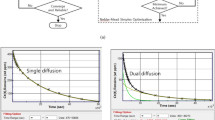Abstract
The transport behavior of commercial R134a (1,1,1,2-tetrafuoroethane) refrigerant including its permeability, adsorption, and diffusion through rubber composites were investigated. Butadiene-acrylonitrile rubber (NBR), brominated butyl rubber (BIIR), and epichlorohydrin rubber (ECO) were used as a matrix, while silica, carbon black, mica sheet, and graphite were used as fillers in the present study. The effects of rubber structure and geometry, surface polarity, as well as loading of filler on transport behavior were studied to correlate transport parameters with the rubber structure and filler nature. The R134a permeation in rubber composites was largely dominated by diffusion rather than solubility. The polarities of rubber and filler played dominant roles in determining the solubility, whereas the structure of rubber and the shape and loading of filler exerted a stronger effect on diffusion than solubility. Nonpolar and layered graphite-filled BIIR rubber composites showed the lowest permeability to R134a. Additionally, shell-like free volume theory was applied to reasonably explain R134a transport behavior.





Similar content being viewed by others
References
Gent AN (1992) Engineering with rubber, how to design rubber components. Hanser (Chapters 1 and 8)
Nah CW, Ryu HJ, Kim WD, Choi SS (2002) Barrier property of clay/acrylonitrile-butadiene copolymer nanocomposite. Polym Adv Technol 13:649–652
Goto SI, Kimura K, Yamamoto T, Yamashita S (1999) A novel gas-barrier elastomer composed of butyl rubber and polyamide. J Appl Polym Sci 74:3548–3552
George SC, Thomas S (2001) Transport phenomena through polymeric systems. Prog Polym Sci 26:985–1017
Koros WJ (1990) Barrier polymers and structures, vol 423, ACS Symp Ser. American Chemical Society, Washington DC, pp 1–21
Naylor T (1989) Permeation properties in handbook of comprehensive polymer science, vol 2. Pergamon Press, UK, pp 1–643
Aminabhavi TM, Aithal US, Shukla SS (1989) Molecular transport of organic liquids through polymer films. J Macromol Sci 29:319–363
Sujith A, Unnikrishnan G (2005) Barrier properties of natural rubber/ethylene vinyl acetate/carbon black composites. J Mater Sci 40:4625–4640
Him HW, Park HB (2011) Gas diffusivity, solubility, and permeability in polysulfone-poly(ethylene oxide) random copolymer membranes. J Membr Sci 372:116–124
Chen GQ, Scholes CA, Qiao GG, Kentish SE, Pammini M, Radhakrishnan CK, Sujith A, Unnikrishnan G, Purushothaman E (2006) Molecular transport of aliphatic hydrocarbons through styrene butadiene rubber/ethylene vinyl acetate blends. J Appl Polym Sci 101:2884–2894
Stephen R, Varghese S, Joseph K, Oommen Z, Thomas S (2006) Diffusion and transport through nanocomposites of natural rubber (NR), carboxylated styrene butadiene rubber (XSBR) and their blends. J Membr Sci 282:162–170
Stephen R, Tanganathaiah C, Varghese S, Joseph K, Thomas S (2006) Gas transport through nano and micro composites of natural rubber (NR) and their blends with carboxylated styrene butadiene rubber (XSBR) latex membranes. Polymer 47:858–870
Johnson T, Thomas S (1999) Nitrogen/oxygen permeability of natural rubber, epoxidised natural rubber and natural rubber/epoxidised natural rubber blends. Polymer 40:3223–3228
Kucukpinar E, Doruker P (2006) Molecular simulations of gas transport in nitrile rubber and styrene butadiene rubber. Polymer 47:7835–7845
Rutherford SW, Limmer DT, Smith MG, Honnell KG (2007) Gas transport in ethyleneepropyleneediene (EPDM) elastomer: molecular simulation and experimental study. Polymer 48:6719–6727
Mathew TV, Kuriakose S (2007) Molecular transport of aromatic hydrocarbons through lignin-filled natural rubber composites. Polym Compos 28:15–22
George S, Varughese KT, Thomas S (2000) Molecular transport of aromatic solvents in isotactic polypropylene/acrylonitrile-co-butadiene rubber blends. Polymer 41:579–594
Thomas PC, Tomlal JE, George G, Thomas S, Joseph K (2012) Effect of filler geometry on the diffusion and transport behavior of aromatic solvents and commercial oil through nitrile rubber nanocomposites. Polym Compos 33:2236–2244
Igwe IO, Ezeani OE (2012) Studies on the transport of aromatic solvents through filled natural rubber Int J Polym Sci 212507
Manoj KC, Kumari P, Rajesh C, Unnikrishnan G (2010) Aromatic liquid transport through filled EPDM/NBR blends. J Polym Res 17:1–9
Sanguansat P, Amornsakchai T (2015) Effect of matrix morphology on mechanical and barrier properties of polypropylene nanocomposite films containing preferentially aligned organoclay platelets. J Polym Res 22:30
Divya VC, Pattanshetti VV, Suresh R, Sailaja RRN (2013) Development and characterisation of HDPE/EPDM-g-TMEVS blends for mechanical and morphological properties for engineering applications. J Polym Res 20:51
Thomas PC, Thomas SP, George G, Thomas S, Kuruvilla J (2011) Impact of filler geometry and surface chemistry on the degree of reinforcement and thermal stability of nitrile rubber nanocomposites. J Polym Res 18:2367–2378
Balachandran M, Bhagawan SS (2012) Mechanical, thermal and transport properties of nitrile rubber (NBR)-nanoclay composites. J Polym Res 19:9809
Van Amerongen GJ (1950) Influence of structure of elastomers on their permeability to gases. J Polym Sci 5:307–332
Stefanis E, Panayiotou C (2008) Prediction of hansen solubility parameters with a new group-contribution method. Int J Thermophys 29:568–585
Anil Kumar PV, Varughese KT, Thomas S (2012) Effect of rubber-filler interaction on transport of aromatic liquids through high density polyethylene/ethylene propylene diene terpolymer rubber blends. Ind Eng Chem Res 51:6697–6704
Wang ZF, Wang B, Qi N, Zhang HF, Zhang LQ (2005) Influence of fillers on free volume and gas barrier properties in styrene-butadiene rubber studied by positrons. Polymer 46:719–724
Ohashi H, Ito T, Yamaguchi T (2010) Prediction of self-diffusivity in multicomponent polymeric systems using shell-like free volume theory. Ind Eng Chem Res 49:11676–11681
Acknowledgments
The authors gratefully acknowledge the financial support of the Natural Science Foundation of China (NSFC; No. 51206053), and the Fundamental Research Funds for the Central Universities (No. 2013ZZ0021).
Author information
Authors and Affiliations
Corresponding authors
Rights and permissions
About this article
Cite this article
Pei, L., Chi, J. & Zhang, L. Transport behavior of R134a refrigerant through rubber composites. J Polym Res 22, 139 (2015). https://doi.org/10.1007/s10965-015-0764-9
Received:
Accepted:
Published:
DOI: https://doi.org/10.1007/s10965-015-0764-9




